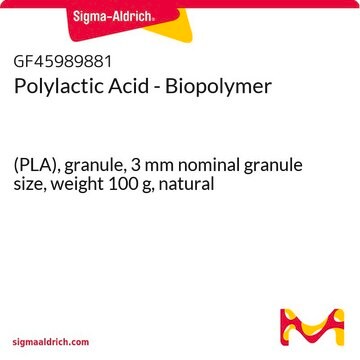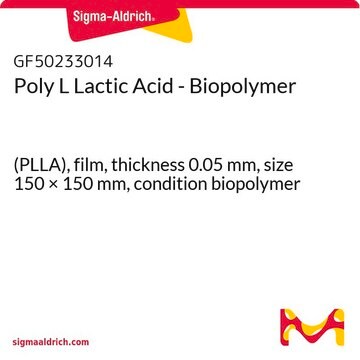38534
Polylactic acid
Mw ~60,000
Synonyme(s) :
Poly(2-hydroxypropionic acid)
About This Item
Produits recommandés
Forme
solid
Durée de conservation
limited shelf life, expiry date on the label
Poids mol.
Mn ~30,000
Mw ~60,000
InChI
1S/C3H6O3/c1-2(4)3(5)6/h2,4H,1H3,(H,5,6)
Clé InChI
JVTAAEKCZFNVCJ-UHFFFAOYSA-N
Vous recherchez des produits similaires ? Visite Guide de comparaison des produits
Description générale
Application
It can be used to prepare PLA/polyvinyl alcohol wound dressing membrane through electrospinning and coating method. The coating of PLA improves the mechanical strength of nanofiber and acts as a protective layer to control the release of drug to the wound site.
It can also be used to synthesize free-standing, flexible ultra-thin PLA nanofilms which can act as a matrix for adhesion, spreading, and proliferation of skeletal muscle cells.
Caractéristiques et avantages
- Biocompatibility
- Lower toxicity
- Low cost
- Better encapsulation
Produit(s) apparenté(s)
Code de la classe de stockage
11 - Combustible Solids
Classe de danger pour l'eau (WGK)
WGK 3
Point d'éclair (°F)
Not applicable
Point d'éclair (°C)
Not applicable
Équipement de protection individuelle
Eyeshields, Gloves, type N95 (US)
Certificats d'analyse (COA)
Recherchez un Certificats d'analyse (COA) en saisissant le numéro de lot du produit. Les numéros de lot figurent sur l'étiquette du produit après les mots "Lot" ou "Batch".
Déjà en possession de ce produit ?
Retrouvez la documentation relative aux produits que vous avez récemment achetés dans la Bibliothèque de documents.
Les clients ont également consulté
Articles
Electrospinning technique applications discussed, emphasizing control of nanofibers and assembly into 3D architectures.
Electrospinning technique applications discussed, emphasizing control of nanofibers and assembly into 3D architectures.
Electrospinning technique applications discussed, emphasizing control of nanofibers and assembly into 3D architectures.
Electrospinning technique applications discussed, emphasizing control of nanofibers and assembly into 3D architectures.
Notre équipe de scientifiques dispose d'une expérience dans tous les secteurs de la recherche, notamment en sciences de la vie, science des matériaux, synthèse chimique, chromatographie, analyse et dans de nombreux autres domaines..
Contacter notre Service technique









